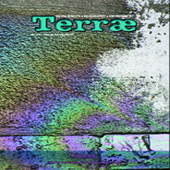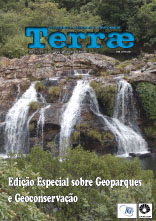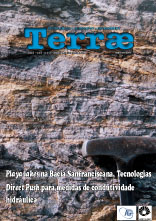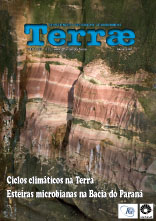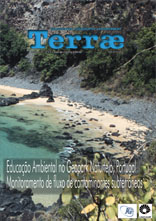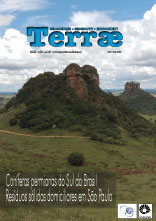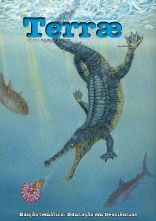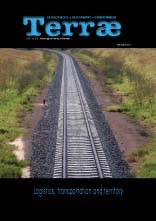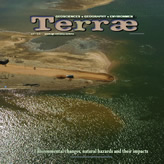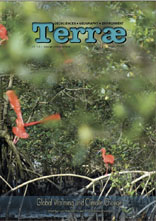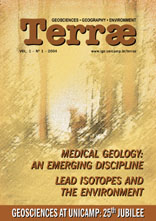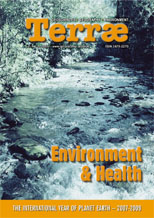Save the date / Call for papers
A revista Terræ publica simultaneamente as edições online de 2016 e 2017. As edições impressas acham-se temporariamente suspensas, pois os editores reconhecem que a internet oferece formas mais eficazes para disseminar rapidamente os resultados das pesquisas. As reformulações do periódico objetivam ampliar a abrangência, combinando redução de custos com rapidez de publicação. Cada vez mais a revista consolida a tendência de cobrir temas multidisciplinares que revelem formas de interação das Geociências com as diferentes áreas do conhecimento humano. A edição de Terræ 2017 é inteiramente dedicada ao tema GEOPARQUES.
A revista aceita trabalhos e comunicações em Português, Inglês e Espanhol.
Chamada de trabalhos / CALL FOR PAPERS
Uma vez recuperado o tempo de ausência na web, a edição de Terræ 2018 tornar-se-á uma boa opção para publicação de artigos científicos. O volume deverá reunir contribuições referentes a GEOÉTICA, tema que permite acomodar abordagens diferenciadas que revelem as inter-relações entre a sociedade e os ecossistemas terrestres.
O sistema de submissão e avaliação de artigos científicos está em pleno funcionamento, sendo feito exclusivamente pelo E-mail: terrae@ige.unicamp.br. Nosso sítio web está à sua disposição.
Esperamos sua visita e participação!
Os editores.
10/01/2018- 16:31 pm
Chamada de trabalhos/ Call for papers para o Volume 15, 2018
Novas contribuições são aceitas para o volume 2018 de Terræ.
Data limite 30.abril.2018
10/01/2018- 16:31 pm
Chamada de trabalhos/ Call for papers para os eventos:
VIII GeoSciEd 2018 – the 8th Quadrennial Conference of the
International Geoscience Education Organisation (IGEO)
– Geosciences for Everyone –
VIII Simpósio Nacional de Ensino e História de
Ciências da Terra / EnsinoGEO-2018
– Geociências para Todos –
Campinas – Sao Paulo – Brazil, July 2018
Acesse o site: http://www.ige.unicamp.br/geoscied2018/en/.
Data limite 11.fevereiro.2018
11/01/2018- 13:40 pm
Livro "Geologia do Brasil”, 2012: Reserve já seu exemplar, sem despesas de remessa.
Visite o endereço eletrônico: www.editorabeca.com.br
Os editores
Campinas, janeiro de 2018.
In Situ Carbonation of Peridotite for CO2 Storage
Several studies dealing with different options and means of CO2 storage include the following alternatives: deep saline formations, oil and gas reservoirs, coalbeds, oceans and forests. But, there is another way: tectonically exposed peridotite from the Earth’s upper mantle and serpentinite, its hydrous alteration product, have been considered promising reactants for conversion of atmospheric CO2 to solid carbonate. In Proceedings of the National Academy of Sciences, Kelemen and Matter (2008) suggest an interesting alternative: pumping the gas from places where it is produced and into underground strata of peridotite. However, engineered techniques for ex situ mineral carbonation have many challenges, such as: kinetics are slow unless olivine and serpentine reactants are ground to powder, heat-treated, and kept at elevated pressure and temperature. Despite these technological constraints, the authors suggest that by drilling and fracturing the rock it’s possible to start a process that increases the absorption rate by 100,000 times or more. The Omani outcrop is estimated to be capable of absorbing 4 billion tons of CO2 a year, which is a substantial portion of the 30 billion tons of the anthropogenic gas emitted into the atmosphere yearly. Additional information can be found in Kelemen, P.B.; Matter,J. 2008. In situ carbonation of peridotite for CO2 storage. Proceedings of National Academy of Science of USA, November 11, vol. 105, n.45, 17295–17300.
Available at: www.pnas.org/cgi/doi/10.1073/pnas.0805794105.
CO2 Capture and Storage – International Energy Agency (IEA)
The IEA Greenhouse Gas R&D Programme provides a handful of websites with a collection of resources related to the capture and storage of CO2. Deep reductions in greenhouse gas emissions are required in order to meet the UNFCC goal of stabilizing anthropogenic greenhouse gas emissions. The information is available at http://www.co2captureandstorage.info/
A PDF reader is required to view the article files. Make the download here: Adobe Acrobat or Foxi


